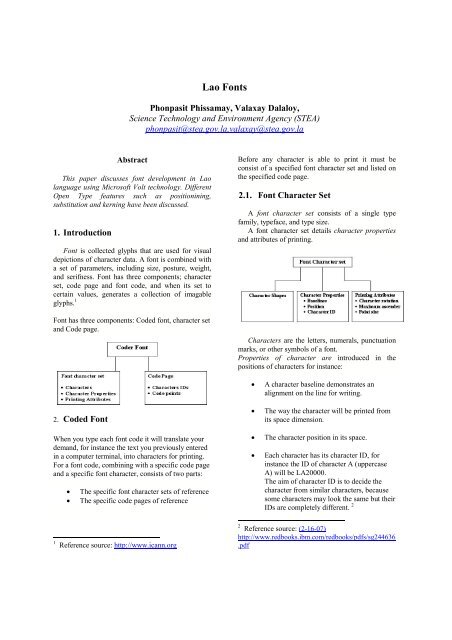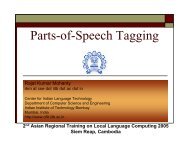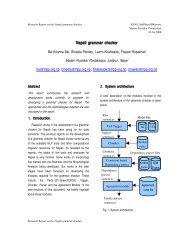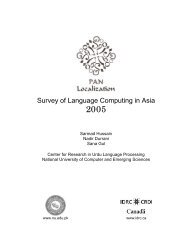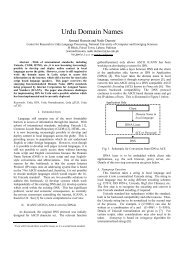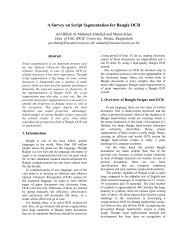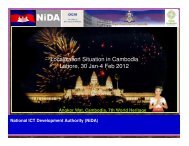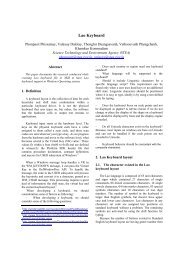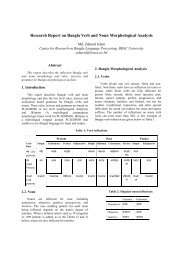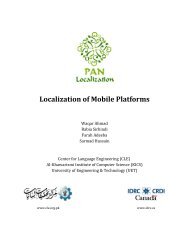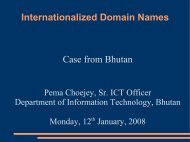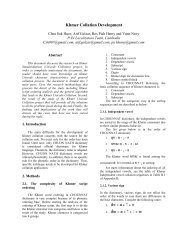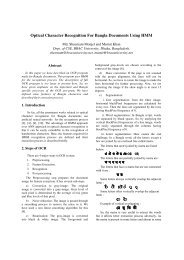Lao Fonts
Lao Fonts
Lao Fonts
You also want an ePaper? Increase the reach of your titles
YUMPU automatically turns print PDFs into web optimized ePapers that Google loves.
<strong>Lao</strong> <strong>Fonts</strong><br />
Phonpasit Phissamay, Valaxay Dalaloy,<br />
Science Technology and Environment Agency (STEA)<br />
phonpasit@stea.gov.la,valaxay@stea.gov.la<br />
Abstract<br />
This paper discusses font development in <strong>Lao</strong><br />
language using Microsoft Volt technology. Different<br />
Open Type features such as positionining,<br />
substitution and kerning have been discussed.<br />
1. Introduction<br />
Font is collected glyphs that are used for visual<br />
depictions of character data. A font is combined with<br />
a set of parameters, including size, posture, weight,<br />
and serifness. Font has three components; character<br />
set, code page and font code, and when its set to<br />
certain values, generates a collection of imagable<br />
glyphs. 1<br />
Font has three components: Coded font, character set<br />
and Code page.<br />
Before any character is able to print it must be<br />
consist of a specified font character set and listed on<br />
the specified code page.<br />
2.1. Font Character Set<br />
A font character set consists of a single type<br />
family, typeface, and type size.<br />
A font character set details character properties<br />
and attributes of printing.<br />
Characters are the letters, numerals, punctuation<br />
marks, or other symbols of a font.<br />
Properties of character are introduced in the<br />
positions of characters for instance:<br />
• A character baseline demonstrates an<br />
alignment on the line for writing.<br />
2. Coded Font<br />
When you type each font code it will translate your<br />
demand, for instance the text you previously entered<br />
in a computer terminal, into characters for printing.<br />
For a font code, combining with a specific code page<br />
and a specific font character, consists of two parts:<br />
• The specific font character sets of reference<br />
• The specific code pages of reference<br />
• The way the character will be printed from<br />
its space dimension.<br />
• The character position in its space.<br />
• Each character has its character ID, for<br />
instance the ID of character A (uppercase<br />
A) will be LA20000.<br />
The aim of character ID is to decide the<br />
character from similar characters, because<br />
some characters may look the same but their<br />
IDs are completely different. 2<br />
1 Reference source: http://www.icann.org<br />
2 Reference source: (2-16-07)<br />
http://www.redbooks.ibm.com/redbooks/pdfs/sg244636<br />
– Minus sign (-) Character ID<br />
SA000000;<br />
– Hyphen (-) Character ID<br />
SP100000;<br />
– Em dash (--) Character ID<br />
SM900000<br />
The printing attributes define how the font<br />
character set will be printed. Some printing attributes<br />
include rotation of characters, maximum ascender,<br />
and point size.<br />
−<br />
Level 3: This level is the main level of <strong>Lao</strong><br />
word. There is always a character at level 3 at<br />
each position in a <strong>Lao</strong> word. All thirty-three<br />
consonants as well as the before and after<br />
vowels twelve and 2 special symbols are also<br />
at level 3. However some consonants and<br />
vowels are also extended into level 2 and level<br />
4 such as:<br />
2.2. Code Page<br />
A code page will chart the text character of the font<br />
character set, and each keyboard character will<br />
interpret into a code point when you enter the text at<br />
a computer terminal. Then, each code point will be<br />
matched to its character ID on the code page when<br />
you print the text, and the character ID will also<br />
match the character image in front of the character<br />
set that you indicated. 3<br />
The image in the character set is the image that is<br />
printed.<br />
− Level 4: The characters appearing in level 4<br />
is lowered script vowels and one mixed<br />
consonant. There are following symbols:<br />
Due to the four levels structure, the high and<br />
length of characters existed in each level are not the<br />
same. If considering the character in the level 3 is<br />
main for compare then the size of character in level2<br />
and lvel4 are equivalent 50% of size of character in<br />
level3. And the size of character in level1 is<br />
equivalent 50% of size of character in level2<br />
3.2. The type of <strong>Lao</strong> characters:<br />
The type of <strong>Lao</strong> characters development also<br />
impacted from the country development such as<br />
regime and equipment facilities. However it can be<br />
classified into 3 groups:<br />
A character ID is an 8-byte character data string.<br />
A code point is an 8-bit binary number representing<br />
one of 256 potential characters (the maximum<br />
number of characters available on a code page).<br />
Code points are usually shown as hexadecimal<br />
representations of their binary values.<br />
Binary: 11000001; Decimal: 193; Hexadecimal:<br />
C1<br />
3. Word in <strong>Lao</strong><br />
1. The traditional or old typewriter: Based on<br />
MAHASILA grammar book (Old <strong>Lao</strong> Grammar)<br />
this has been developed during the royal regime<br />
(before 1975). The characteristic is rounded<br />
glyphs with thin and uniform-width strokes.<br />
Example:<br />
2. The new typewriter or schoolbook in present:<br />
Based on PHOUMY VONGVICHITH grammar<br />
book (new <strong>Lao</strong> grammar) this has been<br />
developed after establishment of LAO PDR<br />
(after 1975). The characteristic is glyphs with<br />
straight strokes where possible, and somewhat<br />
heavier uniform-width strokes. Example:<br />
3.1. Structure of <strong>Lao</strong> syllable:<br />
3<br />
− Level 1: The character appearing in level 1<br />
is of diacritic type. There are five diacritic<br />
namely:<br />
−<br />
Level 2: Level 2 is occupied by superscript<br />
vowels only. The seven vowels of level 2 are:<br />
Reference source: http://www.redbooks.ibm.com/<br />
redbooks/pdfs/sg244636.pdf<br />
3. Ornamental glyph: The new development glyph<br />
in order to make the <strong>Lao</strong> character look more<br />
beauty. The most of the modern glyphs are<br />
developed since last five year after the computer<br />
has created a big impact into the printing<br />
materials. Most of this glyphs are using in the<br />
brochure, advertisement letter or magazine. The<br />
characteristic is calligraphic strokes, handwriting<br />
styles. Example:<br />
--
4. <strong>Lao</strong> <strong>Fonts</strong><br />
4.1. Factors for considerations:<br />
<strong>Lao</strong> font has four main factors to consider:<br />
- The word-wrapping is important for large<br />
amounts of text and it would be much more<br />
convenience, especially for line breaking. But when<br />
the text must be edited, preventing minor changes<br />
from every subsequent line needing adjusting.<br />
- When the text consists of <strong>Lao</strong> and roman characters<br />
in single font of Unicode there would not have a<br />
problem, however, it is a problem when the texts<br />
mixed languages are in a single entry by using ASCII<br />
font.<br />
- Some <strong>Lao</strong> fonts use the standard codes for numbers<br />
and arithmetic symbols, for other characters can lead<br />
to program errors, especially in spreadsheet and<br />
database applications. The hyphen code is often<br />
recognized as a minus sign, and must be used with<br />
care.<br />
- <strong>Lao</strong> fonts have a few heading signs for brochures<br />
and books but they use signs from a wide range of<br />
font styles. 4<br />
What style the font is drawing in must be decided<br />
before drawing even the first character so that they<br />
will all be balanced in shape and style. It is important<br />
to decide on basic width for character in reference to<br />
the showing position, especially for the tone mark<br />
and superscript vowels they have many different<br />
positions placed in the syllable.<br />
4.2. Methodologies:<br />
There are 3 stages for <strong>Lao</strong> shaping engine processes<br />
text:<br />
1. Characters are analyzed for valid diacritic<br />
combinations.<br />
2. Shape is substituted glyphs with OTLS (Open<br />
Type Library Services).<br />
3. Position glyphs with OTLS.<br />
4.2.1. Analyzing characters<br />
The contextual analysis engine is to prove valid<br />
diacritic combinations, and its shaping engine unit is<br />
a string of Unicode characters, in a sequence. For<br />
more information please see Invalid Combing Marks.<br />
The handling of the AM in the analysis phase is<br />
special and where an above mark does not exist on<br />
the preceding base consonant its characteristics will<br />
be use to decompose the AM into the NIGGAHITA<br />
and AA glyphs. Then its glyphs will allow to be<br />
positioned correctly above the preceding base<br />
consonant. If the tone mark is on the base consonant<br />
the analysis engine will decompose the AM and<br />
reorder the NIGGAHITA to between the base<br />
consonant and the tone mark. The NIGGAHITA<br />
glyph will be positioned correctly above the base<br />
consonant, and the tone mark to be positioned<br />
correctly above the NIGGAHITA. This kind of<br />
method cannot be tested in VOLT, as this logic is not<br />
in VOLT.<br />
4.2.2 Shape Glyphs<br />
Shaping character string of Uniscribe is to map all<br />
the characters to the glyphs form. The Unicribe uses<br />
OTLS to relate the characteristics. The processing of<br />
OTL is separated to a set of predefined<br />
characteristics, which apply one by one to the glyphs<br />
in the syllable and then the OTLS will process them.<br />
4.2.1. Position Glyphs with OTLS<br />
The position of glyphs with OTLS to position the<br />
glyphs, Uniscribe applies to the function of OTLS<br />
for help.<br />
Characteristics the positioning:<br />
● Kerning: Using the characteristic of kerning to<br />
offer pair kerning between base glyphs that needed<br />
adjustment for a better typographic quality.<br />
● Mark to base: Using the characteristic of marking<br />
the diacritic glyphs position to base glyphs.<br />
● Mark to Mark: Using characteristic of Mark to<br />
mark to position the diacritic glyphs to base glyphs. 5<br />
4.2.2. Invalid Combining Marks<br />
Combining marks and signs with a valid consonant<br />
base is invalid. Uniscribe displays these marks by<br />
using fallback to render mechanism that defined in<br />
the Unicode standard (section 5.12, 'Rendering Non-<br />
Spacing Marks' of the Unicode Standard 3.0) and<br />
positioned on a dotted circle.<br />
A <strong>Lao</strong> OTL font consists of glyphs for the dotted<br />
circle (U+25CC) if we want fallback mechanism to<br />
work properly.<br />
When the glyphs disappear from the font, the invalid<br />
signs will display on its glyphs shape.<br />
4<br />
Reference source: http://www.cicc.or.jp/english/<br />
hyoujyunka/mlit4/7-5LAOPDR/<strong>Lao</strong>s1.htm<br />
5<br />
Reference source: (5-1-03) http://www.asia.<br />
microsoft.com/typography/otfntdev/laoot/shaping.h<br />
tm
<strong>Lao</strong> words can not use a space code to separate<br />
words when using <strong>Lao</strong> Unicode font. So they use<br />
zero width space (U+200B) to divide word<br />
boundaries. In addition, some applications use a<br />
lexical lookup to do word wrapping.<br />
When finding an invalid combination, a dotted<br />
circle needs to be placed to indicate to the user the<br />
invalid combination. The non-Open Type fonts<br />
shaping engine would impact the invalid mark<br />
combinations to overtrick. To solve the problem<br />
there insert a dotted circle, but not into the backing<br />
store of application because it is a running time<br />
insertion into the glyphs array, which would return<br />
from the script shape function. The list below is the<br />
invalid diacritic logic. You can see that its mark is<br />
not placed in the same system base. 6<br />
Class Description Code points<br />
ABOVE1<br />
ABOVE2<br />
BELOW1<br />
BELOW2<br />
Above mark closest to<br />
base<br />
Second level above<br />
mark<br />
Below mark closest to<br />
base<br />
Second level below<br />
mark<br />
U+0EB1,<br />
U+0EB4,<br />
U+0EB5,<br />
U+0EB6,<br />
U+0EB7,<br />
U+0EBB,<br />
U+0ECD<br />
U+0EC8,<br />
U+0EC9,<br />
U+0ECA,<br />
U+0ECB,<br />
U+0ECC<br />
U+0EBC<br />
U+0EB8,<br />
U+0EB9<br />
<strong>Lao</strong> Character Glyph at Syllable Structure<br />
4.3.2. Kerning<br />
Characteristic of kerning is used to adjust space and<br />
stable spacing between glyphs. A well designed<br />
typeface needs to stable overall the inter-glyphs<br />
spacing. Some characteristics of combined glyphs<br />
need to be implemented as a MarkToLigature.<br />
The standard adjustment in the horizontal or vertical<br />
direction can use size-dependent kerning data via<br />
device table. The cross-stream kerning in the Y text<br />
direction and adjustment of glyph placement is<br />
independent of the advance adjustment. This<br />
characteristic will not be used in mono-space fonts.<br />
The font stores a set of adjustments for pairs of<br />
glyphs, including one or more tables matching left<br />
and right classes or individual pairs.<br />
If both forms are used, the classes should be listed<br />
last; replacing any non-ideal value will result from<br />
the class tables. It will provide adjustment for larger<br />
sets of glyphs to overwrite the results of pair kerns in<br />
combinations. These should be in front of the pairs.<br />
Example:<br />
Vowel:AM The AM character U+0EB3<br />
4.3. <strong>Lao</strong> Font feature:<br />
4.3.1. Shape characteristic of <strong>Lao</strong> Characters.<br />
The shape of <strong>Lao</strong> character can classify into 6<br />
groups:<br />
Using Microsoft VOLT to kern the pairs of glyphs<br />
Before Kerning<br />
After Kerning<br />
6<br />
Reference source: (5-1-03) http://www.asia<br />
.microsoft.com/typography/otfntdev/laoot/other.htm<br />
4.3.3. Mark to base positioning<br />
The 'mark' characteristic positions mark glyphs<br />
that related to a ligature glyph. Its feature implements<br />
as a MarkToLigature.
Example:<br />
5. Reference:<br />
[1] “Microsoft Fontlap Open Type”<br />
http://www.microsoft.com/fontlap/OpenType%20De<br />
v/lao/intro.mspx<br />
From: (5-1-03) http://www.asia.microsoft.com/<br />
typography/otfntdev/laoot/features.htm<br />
[2] “<strong>Lao</strong>tian<strong>Fonts</strong>”<br />
http://cg.scs.carleton.ca/~luc/laos.html<br />
Figure 1: The glyphs characteristic of each <strong>Lao</strong><br />
character:<br />
Using Microsoft VOLT to position the mark to mark<br />
Before:<br />
After:<br />
4.3.4 Positioning of mark to mark<br />
The mark to mark is positioning marks glyphs that<br />
are related to another mark glyph. Its characteristic<br />
will work as a MarkToMark. 7<br />
Example:<br />
Positioning mark to mark using Microsoft VOLT<br />
Before:<br />
After:<br />
7<br />
Reference source: (5-1-03) http://www.asi<br />
a.microsoft.com/typography/otfntdev/laoot/feature<br />
s.htm


